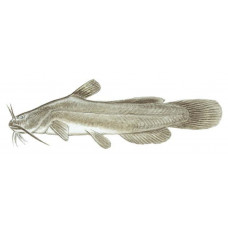Latin name
Noturus flavus
Other names
No information
Identification
Stonecats have an olive, yellowish, or slate-colored upper half of the body and are the only madtoms that exceed 7 inches in total length. Stonecats have spurs that extend backward on the sides of the dental heel on the roof of the mouth. In most cases, Stonecats have a patch on the occiput, a white patch on the back of the dorsal fin base, and another white patch on the top of the caudal fin. There are either no teeth or a few faint teeth on the back of the pectoral fin.
Distribution
The Stonecat has a wide distribution. It is found in the Great Lakes, St. Lawrence River, Hudson Bay drainages, and the Mississippi River basin. It is found from the Hudson River in New York State westward to the Red River in Hudson Bay. It is found in the Mississippi River drainage from Quebec to Alberta, south to northern Alabama and Mississippi, and west to northeastern Oklahoma.
Habitat
The Stonecat usually inhabits the beds of medium to large rivers in places with lots of large rocks. It is also found in lakes where currents or waves create stream-like conditions. In the main channels of large rivers, it is found in fast water on sandy substrate.
Size
Of the 261 specimens collected from streams in Missouri and Illinois, the largest specimens were a 7-inch male and a 6.4-inch female. Growth is most rapid during the first year of life. Specimens up to 5.3 inches are at least 3 years old. Specimens over 6.5 inches reach 4 years or older. The largest and oldest rockfish ever collected had a total length of 12.25 inches and was 9 years old.
Life history and Behavior
Females mature at 3-4 years of age and average 4.7 inches in length. Males guard clutches under large flat rocks in pools or on river ridges. Rocks used as spawning cover averaged 200 square inches and were in an average water depth of 34 inches.
Food and feeding habits
Mayfly larvae are an important food item for stonecats of all sizes. With the exception of individuals over 4.7 inches in standard length, all stonecats consume stonefly, caddisfly, and midge larvae. Stonecats less than 3.1 inches long consume blackfly larvae, while larger individuals consume more crayfish. Like most typical madtoms, stonecats consume a variety of organisms that are rare prey, including fish eggs, worms, amphipods, and chilopods.
Reproduction
No information
| Classification | |
| Phylum | Chordata |
| Class | Actinopterygii |
| Squad | Siluriformes |
| Family | Ictaluridae |
| Genus | Noturus |
| Species | N. flavus |
| Features | |
| Conservation status | Least Concern |
| Habitat | Bottom |
| Life span, years | 9 |
| Maximum body weight, kg | 0.499 |
| Maximum length, cm | 30.48 |
| Sailing speed, m/s | No information |
| Threat to people | No information |
| Way of eating | Bentophage |
Stonecat
Tags: Stonecat

